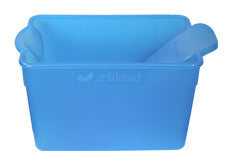AnkleAid - FREE SHIPPING!
$49.99 View productThe first water submersion device designed specifically for ankle and foot therapy. Heals ankles and feet comfortably with a special design that keeps your toes out of the water. If you're not happy with the AnkleAid, we will give you your money back guaranteed.
WHAT IS A CONTRAST BATH (aka Contrast Therapy)?
A contrast bath is a form of hydrotherapy. It is also called hot/cold immersion therapy. It is the use of hot and cold water to help decrease pain and increase circulation in area of injury and restricted blood flow. The goals for a Contrast Bath include:
- Decreasing pain
- Decreasing swelling
- Decreasing/controlling inflammation
- Improving mobility
- Improve muscle recovery after exercising
WHAT IS COMMONLY TREATED WITH A CONTRAST BATH?
A contrast bath is a good modality of choice for injuries that cause swelling and pain around the joints and soft tissue in the body. These can include:
- Acute injuries to limbs or joints (over 72 hours)
- Plantar fasciitis
- Ankle fractures
- Achilles tendinitis
- Hand and finger arthritis
- Conditions with reduced blood flow
- Muscle hypertonicity resulting in cramps or spasms
- Repetitive strain activities, such as carpal tunnel syndrome
- Chronic Regional Pain Syndrome (CRPS)
You should consult your physician or physical therapist if you are unsure it this treatment is right for you.
HOW DOES A CONTRAST BATH WORK?
By providing a significant difference in temperature, there is a greater effect to the tissues being treated to increase blood flow and to decrease swelling. It is a way to strengthen the vascular system in the area of the injury and increase the blood flow and nutrition to the tissues in the area of the injury. The hot water helps to open up the blood vessels, particularly the capillaries, and the cold water constricts them. The alternating between the hot and cold water helps to create a pumping action, which helps to decrease inflammation and promote healing.
WHAT EQUIPMENT IS NEEDED FOR PERFORMING A CONTRAST BATH?
- Two Ankleaid’s
- Thermometer
- Towels (for drying and to put under the Ankleaid’s)
- Pitcher to remove and add hot water & ice
- Means for heating water if not near a tub or sink
WHAT IS THE PROCEDURE FOR A CONTRAST BATH?
Fill two AnkleAids.
- Fill one with hot water (98 -110 degrees Fahrenheit),
- Fill the other one with cold water (55-65 degrees Fahrenheit)
Make sure you use a thermometer to verify the temperatures throughout the whole treatment.
- If swelling is present, keep the temperature below 102 degrees Fahrenheit and make it shorter in duration.
- If a joint is swollen and hot, use cold; never heat
Soak the affected area
- Start in the hot water for 3-4 minutes
- Switch immediately to soaking in the cold water for 1 minute.
Always start with the hot water and end with the cold water, except: Rheumatoid Arthritis – end in the hot water and dry the area thoroughly. If the joint is swollen and hot, then only use cold water
Repeat the above steps three to four (3-4) more times (about 20 minutes)
More hot water may need to be added to maintain the right temperature for the “hot bath” (it might decrease from switching back and forth between the hot and cold water). Add this while soaking in the cold bath. Make sure to stir while adding the hot water to avoid increasing the temperature too much (do not exceed 110 degrees Fahrenheit), which can result in a burn. The extremity being treated will be desensitized from being in the cold water making it difficult to discern if the temperature is too hot.
To increase the effectiveness of the contrast bath, add ice to the cold water to help maintain the temperature between 55 and 65 degrees Fahrenheit.
PRECAUTIONS FOR DOING CONTRAST BATHS
- Contrast Baths should not be done to an acute injury.
- Treatment should not be given until 72 hours have passed since the injury
- Make sure that the room where the Contrast Bath is warm and free of drafts. Cool room temperatures make the contrast baths less effective.
CONTRAINDICATIONS FOR CONTRAST BATHS
DO NOT use Contrast Baths for any of the following problems:
- Local malignancies
- Peripheral vascular disease (PVD)
- Impaired sensation
- Bleeding and acute inflammation.
- Diabetes and neuropathy
- If there is a good pulse in the extremities, diabetics and those with neuropathies can benefit from a contrast bath, but it needs to be under the supervision of a physical therapy.
Again, you should consult your physician or physical therapist if you are unsure if this treatment is right for you.








